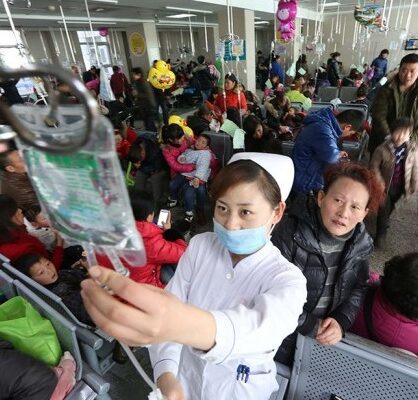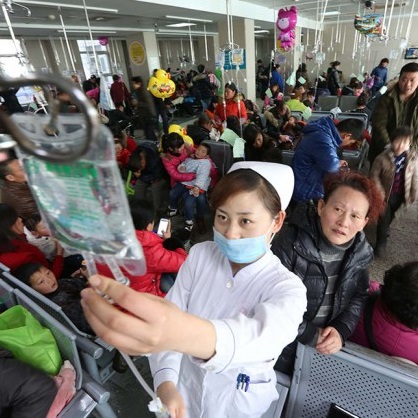Insights and perspectives on the evolving Chinese Healthcare Industry

Over the past decade the Chinese government has spent over $500B in infrastructure and healthcare reform, including the establishment of many new hospitals and policies to satisfy the demand that accompanies China’s population of over a billion people.

by Preetika Vish, Matt Weisse, Matt Wilhelm, Bryan Wong
Paul Zhang, MBA’99 and Managing Director of Life Sciences at Navigant joined Johnson’s Leaders in Emerging Markets course to discuss the growing areas of life sciences, healthcare, and medical devises within the Chinese market, in addition to speaking on the evolving yet challenging aspects of Chinese hospitals, universal healthcare, and insurance. Ultimately, Mr. Zhang was able to highlight the fact that while there is growth throughout many Chinese markets, and while many steps in the right direction have been taken, there is still much progress to be made to establish a truly sustainable system that both encourages private entrants and contributes to better offerings for Chinese society as a whole.
One of the first key takeaways of Mr. Zhang’s lecture was an understanding of the macro trends currently occurring within China. An emerging superpower in many aspects, its growth and high-level trends have a direct impact on Chinese life sciences and healthcare industries. Most notably, China has the largest population in the world, yet growth has slowed in the last several years (in large part due to the one-child policy) and the population has aged considerably, with the percentage of the population aged 60+ climbing from 12% in 2008 to over 20% currently – increasing the demand for high quality healthcare. Furthermore, disposable income has more than tripled from 2005 to 2015, with an estimated 83 million people expected to enter the middle/affluent class by 2020. With this trend, greater number of people are moving from rural locations into cities and the government encourages this as it makes healthcare and other services more convenient to deliver.
With a booming economy and the growth in population, demand, and wealth, nearly all areas of healthcare and life sciences have experienced rapid growth in China. Healthcare expenditure has grown both nominally and as a percentage of GDP, and the government investment in insurance has also grown considerably. The pharmaceutical, medical device, and private hospital industries have seen consistent increases in the last decade. However, Mr. Zhang was careful to note that year-over-year growth alone isn’t everything – per capita expenditures on healthcare remain far below that of other developed countries, 80% of pharmaceuticals are generic (a significantly higher percentage than seen in other developed nations), and the government continues to play a high role in involvement in much of the economy (which can help with certain initiatives, but also restricts private care from growing too quickly).
When looking at the pharmaceutical and medical device industry in China, quality control and patent protection are major factors that affect both the local market and exports. As medical spending has increased, local firms have made major strides to both produce for the Chinese market and to manufacture for global customers. Interestingly, Chinese hospitals have been the primary disturber of prescription drugs and devices to patients, as opposed to pharmacy-based distribution seen elsewhere.
Moreover, as more of the population participates in the healthcare system this could become a greater burden on already overwhelmed hospitals, and pharmacies becoming more predominant could accelerate healthcare spending further as similar steps toward the “retailization” of medicine have done in the US. The value chain for drug sales from manufactures to distributors (doctors and hospitals) already resembles the US sales rep system. As China’s government agency’s ramp up their regulation of this market there have been growing pains; an example is how GlaxoSmithKline was fined $500M for bribery that resulted in $150M of illicit sales in 2014.
As in other major emerging markets, there is a significant need for cheaper alternatives to high-cost patent protected drugs. Most of China’s drug development industry is focused on the generic market, due to the fact that as a member of the WTO, China is compelled to protect any drugs with a patent filed in the country. Recent legislation has created instances where patent protection can be overwritten in emergency cases both at home and abroad. More regularly, Chinese firms produce generics by modifying drug composition just enough to be outside of the patent restricts, yet still similar enough to achieve and equal degree of efficacy. In the past few decades, the government has tightened its oversight of manufactures and many generic drugs were taken off the market over concerns of their effectiveness. The medical device market operates similarly – the entrepreneurial culture of China means there will be quick movement to devise more affordable versions of devices.
Exports from China have also been rising continuously, despite occasional questions arising that concern quality control. In the past few years, both Malaria drugs and cough syrup have been recalled internationally. However, after the issues were addressed, production resumed and there are no signs of an ongoing risk to the double digit growth rate of medical manufacturing. While the medical products of China have been expanding and evolving, so has the rest of the value chain of the medical industry. Hospitals in China are primarily public or state owned. These hospitals see an overwhelming number of the visitors – over 90% of all patient visits are to public hospitals. Private hospitals, on the other hand, are typically specialty clinics in areas such as dermatology. While there are a large number of private hospitals, they see only 10% of the overall patient pool. The people see public hospitals as reliable: the public hospitals attract the best doctors of the country due to the fact that the government actively discourages good doctors to enter the private sector. Finally, these public hospitals have the widest insurance coverage in the country making them more affordable for the majority of the population. Private hospitals are largely out of pocket for the patients, and this financial difference further discourages potential patients from selecting private care.
The issue with the system is that these public hospitals require upgrades. Systematic issues with patient flow and efficient management exist in these hospitals. Typically, a hospital visit for a patient in China would likely involve hours of waiting without seeing a doctor. Beyond this, many of these hospitals also require physical infrastructure upgrades. The government has acknowledged this need by implementing new policies targeted at improving the public hospitals.
A private-public partnership would be ideal here, but the adoption has been slow. Private equity firms have made some investments in private hospitals, but they have not been incredibly successful. Public hospitals in China can be an attractive investment, but foreign investors must understand and work with the government. The key here will be to build local relationships and partnerships, and uses these local partners to invest in these opportunities.
The shift in public perception towards public and private hospitals also comes with a shift in perception due to insurance policies. While private hospitals are beginning to pop up for the “me-too” population that want physician care at affordable rates, the transition is not as quick as it could be. In fact, Private Equity and Venture Capitalists looking to take control of the industry have found it rather slow.
The emergence of private hospitals has caused some issues with insurance companies and insurers. At a government sponsored hospital, most of the procedures and care would be covered under insurance. However, patients are finding it difficult to get everything covered in private hospitals, raising costs for the consumer. As was discussed earlier, because of this, the majority of people still prefer to go to public hospitals. While all of this is gradually changing, it will still take a considerable amount of time and it is not something that can be expected to change overnight. Ultimately, it all ties back to the government wanting to control the transition towards increased privatization, and make it manageable and gradual, rather than have a huge influx of private hospitals popping up.
There has also been a huge push towards universal healthcare within China. China’s government has been very aggressive in pushing through policies that would directly affect healthcare reform. As it is a centrally controlled government, these policies can be very far reaching. Over the past decade the government has spent over $500B in infrastructure and healthcare reform, including the establishment of many new hospitals and policies to satisfy the demand that accompanies China’s population of over a billion people. Despite this massive push from the government, progress has been slow, and due to China’s massive population and tax collection, creating comprehensive public and universal healthcare is no small feat. Patience and time will be key: government’s red tape as well as the population’s existing perception and preferences for healthcare with be instrumental in shaping this reform.
Overall, Mr. Zhang presented an interesting glimpse into the Chinese healthcare and pharmaceuticals markets. China is a fascinating place because it possesses a great degree of both opportunities and challenges. On the opportunities end, there is a large population, incredible demand for services and products, governmental interest in driving change, and significant growth in nearly every industry. On the other end of the spectrum, there are still many improvements to be made to drive things such as increased private hospital offerings and deeper insurance coverage, and much of this lays within the hands of a government that enjoys maintaining a decent amount of control. Ultimately, time will tell how things progress, but this is definitely a fascinating space well worth keeping an eye on over the next several years to see how the Chinese market continues to shift and evolve.
